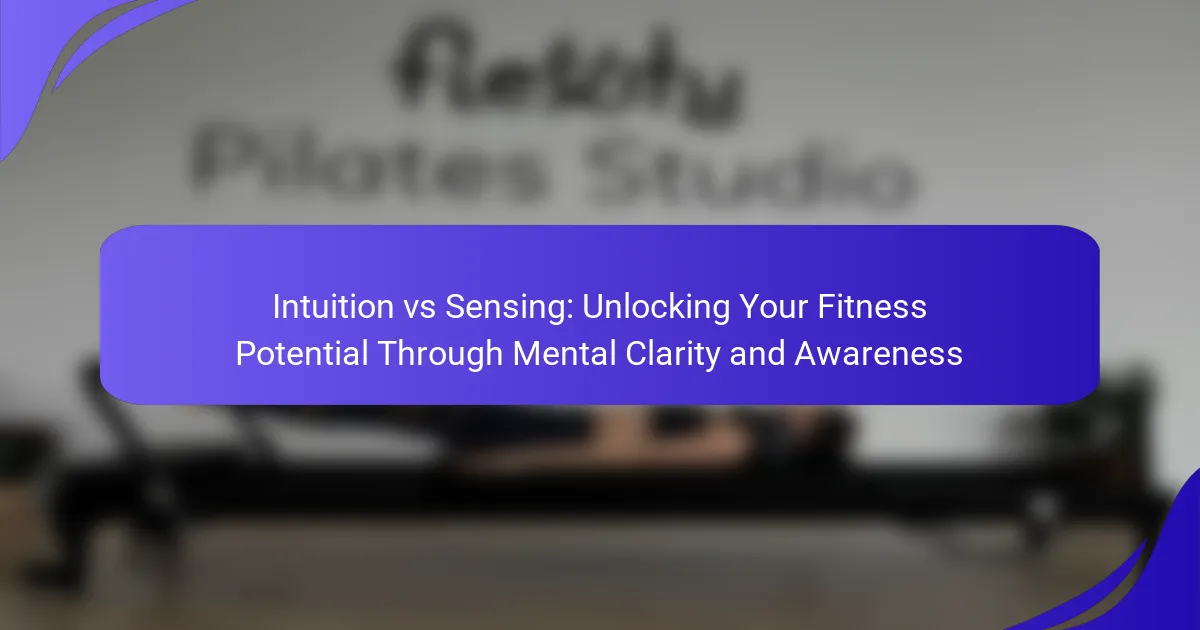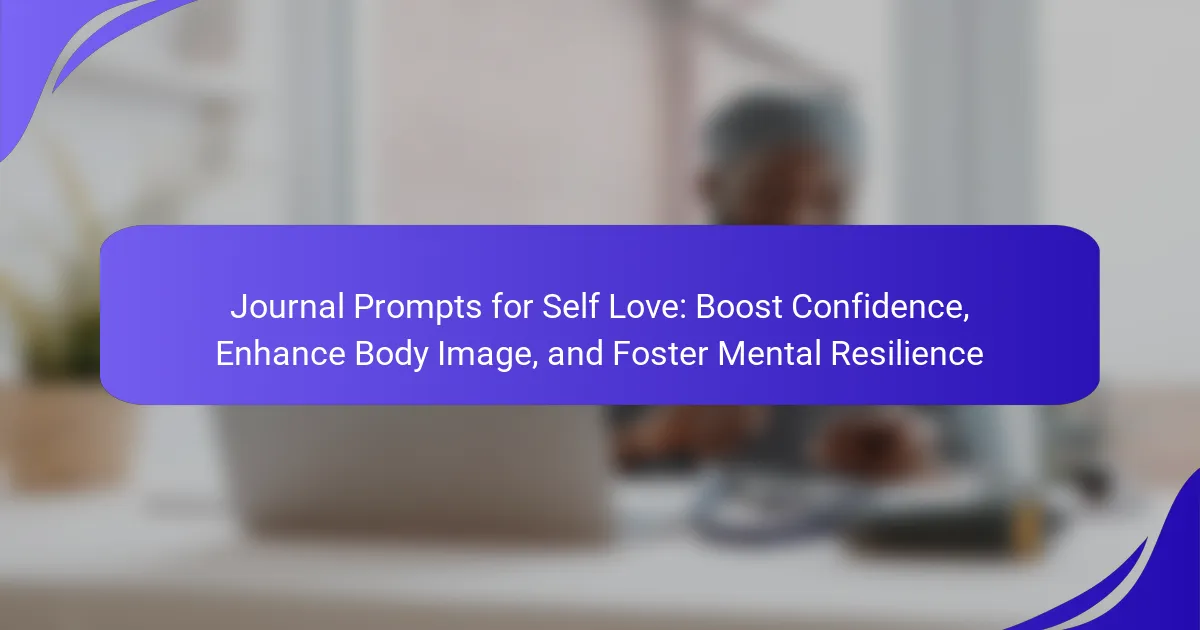Unlock your fitness potential by mastering intuition and sensing. Intuition enhances mental clarity and decision-making, while sensing improves awareness of bodily signals. Understanding their roles can optimise training strategies and prevent injuries. Cultivating both skills fosters a balanced approach to achieving your fitness goals.
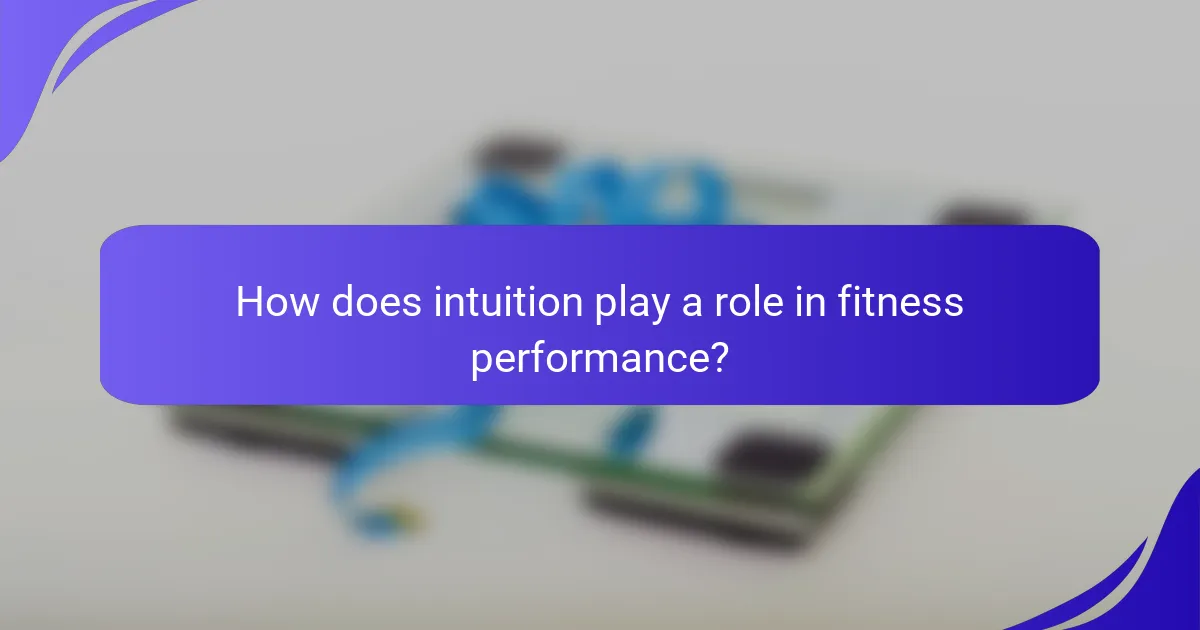
How does intuition play a role in fitness performance?
Intuition significantly enhances fitness performance by promoting mental clarity and self-awareness. When athletes trust their instincts, they can make quicker decisions, leading to improved reactions and adaptability during workouts and competitions. This mental clarity helps in recognising body signals, allowing for optimal pacing and technique adjustments. Research indicates that intuitive decision-making can elevate performance levels, especially in high-pressure situations. By honing this skill, individuals can unlock their full fitness potential.
What are the key characteristics of intuitive decision-making in workouts?
Intuitive decision-making in workouts is characterised by quick, instinctive choices based on body awareness and mental clarity. Key characteristics include heightened self-awareness, trust in one’s instincts, and the ability to adapt to changing circumstances. This approach allows for more fluid and responsive training, enhancing overall performance and enjoyment. Additionally, intuitive decision-making can lead to improved motivation and commitment to fitness goals, as individuals feel more in tune with their bodies and needs.
How can developing intuition enhance physical training?
Developing intuition can significantly enhance physical training by improving mental clarity and awareness. This heightened awareness allows athletes to better understand their bodies, leading to more effective training decisions. Intuitive insights can guide adjustments in technique, pacing, and recovery strategies, ultimately optimising performance. By fostering a deep connection with physical sensations, individuals can unlock their fitness potential and achieve their goals more efficiently.

What is the significance of sensing in achieving fitness goals?
Sensing plays a crucial role in achieving fitness goals by enhancing awareness of bodily signals and mental states. It allows individuals to tune into their physical sensations and emotional responses, fostering better decision-making regarding workouts and nutrition. This heightened awareness can lead to improved performance and motivation. By cultivating sensing, individuals can identify when to push harder or when to rest, ultimately optimising their fitness journey.
How does sensory awareness impact exercise efficiency?
Sensory awareness significantly enhances exercise efficiency by improving focus and body connection. Heightened awareness allows individuals to better tune into their physical sensations, leading to more effective movement and reduced risk of injury. Research indicates that individuals who practice mindfulness during workouts experience greater satisfaction and performance gains. This unique attribute of sensory awareness facilitates a deeper understanding of personal limits and capabilities, ultimately unlocking fitness potential.
What are the benefits of honing your sensory skills in fitness?
Honing your sensory skills in fitness enhances body awareness, improves performance, and increases mental clarity. These benefits lead to better decision-making during workouts, allowing for more effective training sessions. Enhanced sensory skills can help identify physical limitations and optimise techniques, ultimately unlocking your fitness potential.
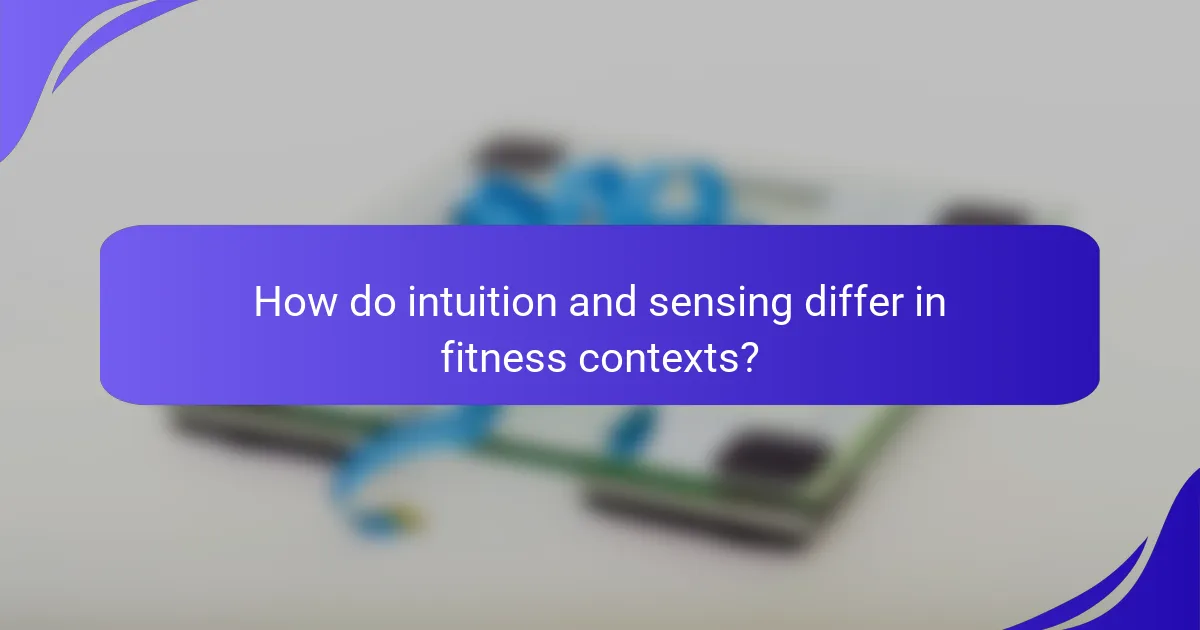
How do intuition and sensing differ in fitness contexts?
Intuition emphasises instinctive decision-making, while sensing relies on concrete data and experiences. In fitness contexts, intuition can guide personal training choices based on feelings, while sensing focuses on measurable metrics like heart rate and performance stats. Understanding this distinction helps individuals optimise their routines by balancing instinct and data-driven insights.
What are the psychological distinctions between intuitive and sensory approaches?
Intuitive approaches emphasise gut feelings and insights, while sensory approaches focus on concrete data and experiences. Intuition fosters creativity and adaptability, enhancing mental clarity. In contrast, sensing promotes analytical thinking and detail-oriented decision-making, supporting structured fitness routines. Understanding these distinctions helps individuals maximise their fitness potential by aligning their mental strategies with personal preferences.
How can understanding these differences improve workout strategies?
Understanding the differences between intuition and sensing can significantly enhance workout strategies. By leveraging mental clarity and awareness, individuals can tailor their fitness routines to align with their personal strengths and preferences.
Intuitive individuals may benefit from flexible workout plans that allow for spontaneous changes, while sensing types might thrive on structured routines with clear, measurable goals. Recognising these distinctions helps in creating personalised strategies that optimise performance and motivation.
As a result, individuals can achieve better results by focusing on their unique mental processing styles, leading to increased engagement and consistency in their fitness journeys.
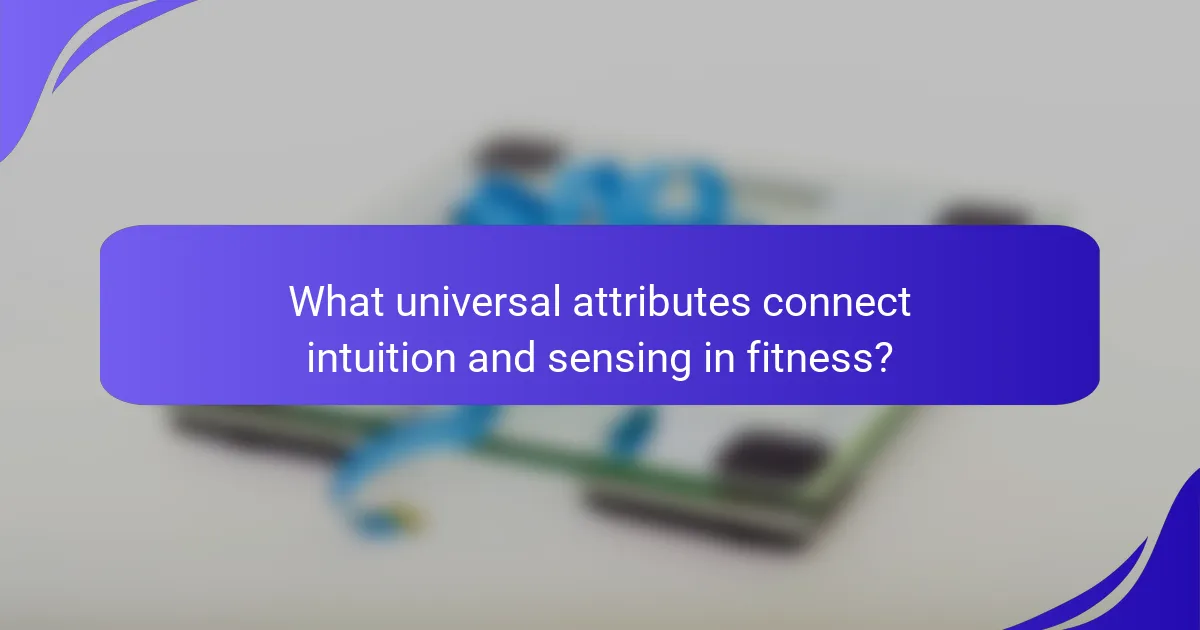
What universal attributes connect intuition and sensing in fitness?
Intuition and sensing in fitness are connected through awareness and mental clarity. Both enhance decision-making and body awareness, allowing individuals to respond effectively to physical cues. Intuition enables quick judgments based on past experiences, while sensing focuses on real-time feedback from the body. Together, they foster a holistic approach to fitness, improving performance and preventing injuries. This synergy enhances overall well-being by promoting a balance between instinctive reactions and mindful awareness.
How do both approaches contribute to overall health and wellness?
Both approaches enhance health and wellness by fostering self-awareness and mental clarity. Intuition encourages individuals to listen to their bodies, leading to personalised fitness decisions. Sensing promotes mindfulness, grounding individuals in the present moment, which reduces stress and enhances motivation. Together, they create a holistic fitness strategy that aligns physical activity with mental well-being. This synergy maximises overall health benefits, ensuring a balanced approach to fitness.
What common practices incorporate both intuition and sensing?
Common practices that incorporate both intuition and sensing include mindfulness meditation, body awareness exercises, and intuitive eating. These practices enhance mental clarity and awareness, allowing individuals to connect with their inner guidance while being attuned to physical sensations. Mindfulness meditation fosters a heightened sense of present awareness, while body awareness exercises help individuals recognise their physical state and emotions. Intuitive eating encourages listening to the body’s hunger cues instead of external diet rules, promoting a balanced relationship with food.
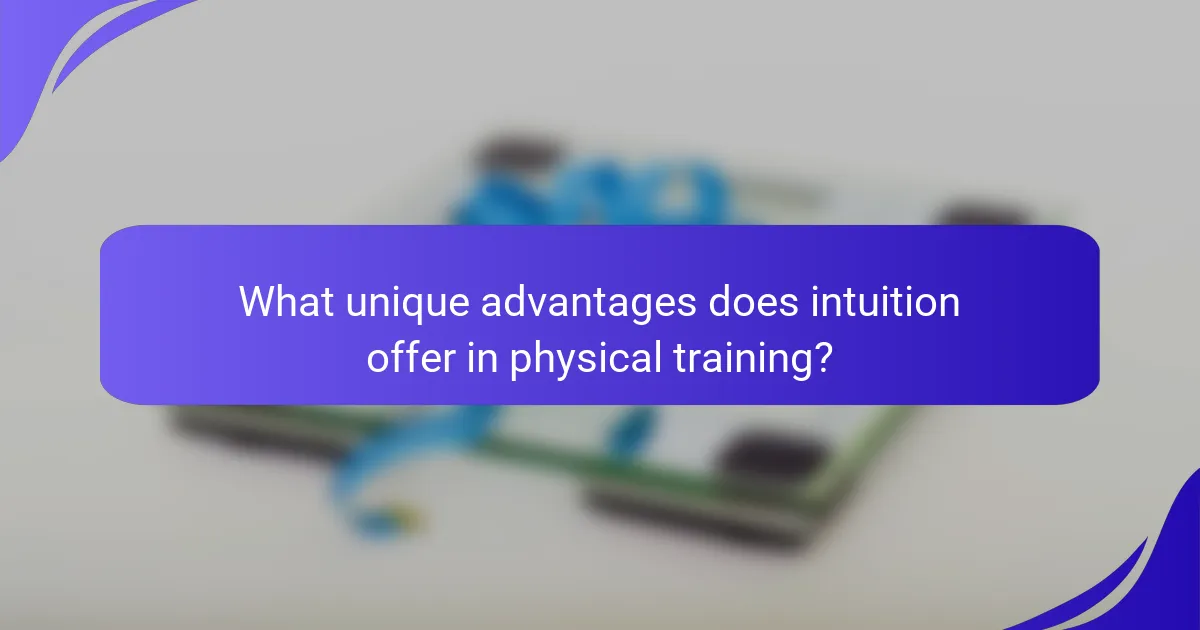
What unique advantages does intuition offer in physical training?
Intuition offers unique advantages in physical training by enhancing body awareness and decision-making. It facilitates quicker responses to physical demands, allowing athletes to adapt movements instinctively. This mental clarity leads to improved performance and reduces the likelihood of injury. Additionally, intuitive training fosters a deeper connection between mind and body, optimising workout efficiency.
How can intuition lead to personalized fitness plans?
Intuition can lead to personalised fitness plans by enhancing self-awareness and responsiveness to body signals. This mental clarity allows individuals to identify their unique needs and preferences, leading to more effective workout routines. By trusting their instincts, people can adjust their activities based on energy levels, mood, and physical sensations, resulting in a tailored approach that maximises engagement and results. Additionally, this intuitive process fosters a deeper connection to one’s fitness journey, promoting long-term adherence and motivation.
What role does intuition play in injury prevention?
Intuition plays a crucial role in injury prevention by enhancing awareness of body signals. This mental clarity allows individuals to recognise potential risks and adjust their activities accordingly. Studies show that athletes who trust their intuition can better avoid injuries by responding to subtle cues, such as fatigue or discomfort. Developing this skill requires practice and mindfulness, ultimately unlocking greater fitness potential.

What rare insights can be gained from combining intuition and sensing?
Combining intuition and sensing reveals unique insights that enhance mental clarity and awareness in fitness. This synergy fosters a deeper understanding of personal limits and potential, allowing for more effective training strategies. Rare insights include the ability to recognise subtle cues from the body, leading to optimised performance and injury prevention. Such awareness can transform routine workouts into tailored experiences that align with individual goals.
How can elite athletes leverage both approaches for peak performance?
Elite athletes can enhance peak performance by integrating intuition and sensing. Intuition allows for quick decision-making based on experience, while sensing provides awareness of physical states and surroundings. This combination fosters mental clarity, enabling athletes to respond effectively in dynamic situations. For example, a runner may intuitively adjust pace while sensing fatigue levels. Balancing these approaches can lead to improved focus and adaptability during competition. By leveraging both attributes, athletes can unlock their full fitness potential.
What uncommon strategies utilize intuition and sensing together?
Intuition and sensing can be combined through mindfulness practices, enhancing fitness potential. Techniques like body scanning and intuitive eating promote awareness of physical sensations and internal cues. These strategies improve decision-making in workouts and recovery, fostering a deeper connection with one’s body. As a result, individuals experience heightened mental clarity and better performance.

What practical steps can enhance your intuition and sensing in fitness?
To enhance your intuition and sensing in fitness, practice mindfulness, engage in regular self-reflection, and maintain a balanced routine. Mindfulness improves awareness of bodily signals, helping you respond to your needs. Self-reflection allows you to assess past experiences, refining your decision-making. A balanced routine, incorporating varied workouts, fosters adaptability and deeper understanding of your body’s capabilities.
How can you train your mind to improve intuition?
To train your mind and improve intuition, practice mindfulness and meditation regularly. These techniques enhance mental clarity and awareness, leading to better decision-making. Engage in activities that stimulate your senses, such as nature walks or creative pursuits, to foster intuitive thinking. Journaling your thoughts and feelings can also help identify patterns and insights, strengthening your intuitive abilities.
What exercises can boost sensory awareness during workouts?
Incorporating exercises that enhance sensory awareness can significantly improve your workout experience. Activities like yoga, tai chi, and dance focus on body awareness, balance, and coordination, sharpening the mind-body connection.
1. Yoga: Promotes mindfulness and body awareness through controlled movements and breathwork.
2. Tai Chi: Encourages slow, deliberate motions that enhance proprioception and spatial awareness.
3. Dance: Engages rhythm and coordination, boosting sensory perception through movement patterns.
4. Pilates: Focuses on core stability and body alignment, fostering awareness of body mechanics.
5. Balance exercises: Activities like standing on one leg or using a balance board improve stability and sensory feedback.
These exercises cultivate mental clarity, helping you unlock your fitness potential through enhanced intuition and sensing.
What common mistakes should be avoided when developing these skills?
To develop intuition and sensing skills effectively, avoid common mistakes such as neglecting mental clarity, underestimating the importance of awareness, and failing to practice consistently. These errors can hinder your fitness potential. Focus on cultivating a balanced approach between intuition and sensing for optimal results. Prioritise self-reflection and mindfulness to enhance your awareness and decision-making abilities.
What expert tips can help optimize your fitness journey through mental clarity?
To optimise your fitness journey through mental clarity, focus on enhancing intuition and awareness. Cultivating mindfulness helps you recognise your body’s needs, leading to better decision-making in your workouts. Utilise techniques like meditation, journaling, and visualization to strengthen your mental focus. Regularly assess your progress to adjust your routines and maintain motivation. Incorporating these practices fosters a deeper connection with your fitness goals, ultimately unlocking your full potential.
